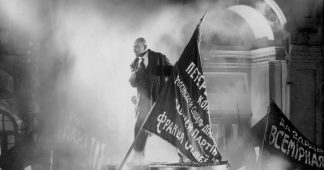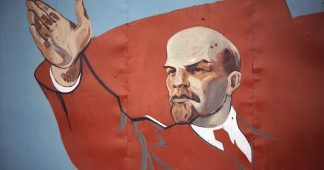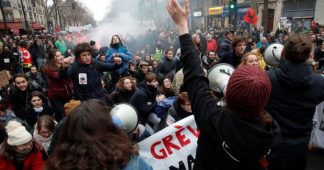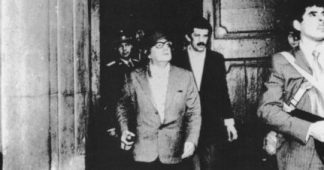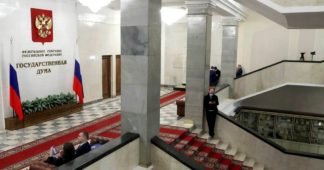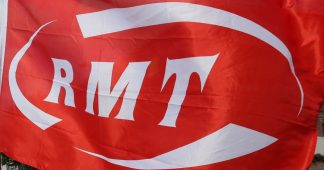Soviets in Action
First Published: October 1918 in The Liberator
Transcription/Markup: Revolutionary History/Brian Baggins
Online Version: John Reed Internet Archive (marxists.org) 2000
Through all the chorus of abuse and misrepresentation directed against the Russian Soviets by the capitalist press there runs a voice shrill with a sort of panic, which cries: ‘There is no government in Russia! There is no organisation among the Russian workers! It will not work! It will not work!’
There is method in the slander.
As all real socialists know, and as we who have seen the Russian Revolution can testify, there is today in Moscow and throughout all the cities and towns of the Russian land a highly complex political structure, which is upheld by the vast majority of the people and which is functioning as well as any newborn popular government ever functioned. Also the workers of Russia have fashioned from their necessities and the demands of life an economic organisation which is evolving into a true industrial democracy.
The Soviet state is based upon the Soviets – or Councils – of Workers, and Peasants’ Soviets. These Councils – institutions so characteristic of the Russian Revolution – originated in 1905, when, during the first general strike of the workers, Petrograd factories and labour organisations sent delegates to a Central Committee. This Strike Committee was named Council of Workers’ Deputies. It called the second general strike of the fall of 1905, sent out organisers all over Russia, and for a short time was recognised by the Imperial Government as the authorised spokesman of the revolutionary Russian working class.
Upon the failure of the 1905 Revolution, the members of the Council either fled or were sent to Siberia. But so astoundingly effective as a political organ was this type of union that all revolutionary parties included a Council of Workers’ Deputies in their plans for the next uprising.
In March 1917, when, in the face of all Russia rearing like a sea, the Tsar abdicated and Grand Duke Michael declined the throne, and the reluctant Duma was forced to assume the reins of government, the Council of Workers’ Deputies sprang fully-fledged into being. In a few days it was enlarged to include delegates of the Army, and called the Council of Workers’ and Soldiers’ Deputies. Except for Kerensky the Duma Committee was composed of bourgeois, and had no connection with the revolutionary masses whatever. Fighting had to be done, order had to be restored, the front guarded. The Duma members had no way of executing these duties; they were obliged to appeal to the representatives of the workers and soldiers – in other words the Council. The Council took charge of the work of Revolution, of co-ordinating the activities of the people, preserving order. Moreover, it assumed the task of assuring the Revolution against its betrayal by the bourgeoisie.
From the moment when the Duma was forced to appeal to the Council, two governments existed in Russia and these two governments struggled for the mastery until November 1917, when the Soviets, with the Bolsheviks in control, overthrew the coalition government.
There were, as I have said, Soviets of both Workers’ and of Soldiers’ Deputies. Somewhat later there came into being Soviets of Peasants’ Deputies. In most cities the Workers’ and Soldiers’ Soviets met together; they also held their All-Russian Congress jointly. The Peasants’ Soviets, however, were held aloof by the reactionary elements in control, and did not join with the workers and soldiers until the November revolution and the establishment of the Soviet Government.
THE SOVIET is based directly upon the workers in the factories and the peasants in the field. At first the delegates of Workers’, Soldiers’ and Peasants’ Soviets were elected according to rules which varied with the needs and population of various localities. In some villages the peasants chose one delegate for each fifty voters. Soldiers in garrison were given a certain number of delegates for each regiment, regardless of its strength; the army in the field, however, had a different method of electing their Soviets. As for the workers in the great cities, they soon found out that their Soviets became unwieldy unless the delegates were limited to one for each five hundred. In the same way, the first two All-Russian Congresses of Soviets were roughly based upon one delegate for each twenty five thousand voters, but in fact the delegates represented constituencies of various sizes.
Until February 1918 anybody could vote for delegates to the Soviets. Even had the bourgeoisie organised and demanded representation in the Soviets, they would have been given it. For example, during the regime of the Provisional Government there was bourgeois representation in the Petrograd Soviet – a delegate of the Union of Professional Men which comprised doctors, lawyers, teachers, etc.
Last March, the constitution of the Soviets was worked out in detail and applied universally. It restricted the franchise to: citizens of the Russian Socialist Republic of both sexes who shall have completed their eighteenth year by the day of election; all who have acquired the means of living through labour that is productive and useful to society and who are members of labour unions. Excluded from the right to vote were: employers of labour for profit; persons who lived on unearned increment; merchants and agents of private business; employers of religious communities; former members of the police and gendarmerie; the former ruling dynasty; the mentally deficient; the deaf and dumb; and those who had been punished for selfish and dishonourable misdemeanours.
As far as the peasants are concerned, each hundred peasants in the villages elect one representative to the Volost, or Township, Soviet. These Volost Soviets send delegates to the Uyezd, or County, Soviets, which in turn send delegates to the Oblast, or Provincial, Soviet, to which also are elected delegates from the Workers’ Soviets in the cities.
The Petrograd Soviet of Workers’ and Soldiers’ Deputies, which was in operation when I was in Russia, may serve as an example of how the urban units of government function under the socialist state. It consisted of about 1200 deputies, and in normal circumstances held a plenary session every two weeks. In the meantime, it elected a Central Executive Committee of 110 members, based upon party proportionality, and this Central Executive Committee added to itself by invitation delegates from the central committees of all the political parties, from the central committees of the professional unions, the factory shop committees, and other democratic organisations.
Besides the big City Soviet, there were also the Rayori, or Ward, Soviets. These were made up of the deputies elected from each ward to the City Soviet, and administered their part of the city. Naturally, in some wards there were no factories, and therefore normally no representation of the ward either in the City Soviet or in Ward Soviets of their own. But the Soviet system is extremely flexible, and if the cooks and waiters, or the street sweepers, or the courtyard servants, or the cab drivers of that ward organised and demanded representation, they were allowed delegates.
Elections of delegates are based on proportional representation, which means that the political parties are represented in exact proportion to the number of voters in the whole city. And it is political parties and programmes which are voted for – not candidates. The candidates are designated by the central committees of the political parties, which can replace them by other party members. Also the delegates are not elected for any particular term, but are subject to recall at any time.
No political body more sensitive and responsive to the popular will was ever invented. And this was necessary, for in time of revolution the popular will changes with great rapidity. For example, during the first week of December 1917, there were parades and demonstrations in favour of a Constituent Assembly -that is to say, against the Soviet power. One of these parades was fired on by some irresponsible Red Guards, and several people killed. The reaction to this stupid violence was immediate. Within twelve hours the complexion of the Petrograd Soviet changed. More than a dozen Bolshevik deputies were withdrawn, and replaced by Mensheviki. And it was three weeks before public sentiment subsided – before the Mensheviki were retired one by one and the Bolsheviki sent back.
AT LEAST twice a year delegates are elected from all over Russia to the All-Russian Congress of Soviets. Theoretically these delegates are chosen by direct popular election: from the provinces, one for each hundred and twenty five thousand voters – from the cities, one for each twenty five thousand; in practice, however, they are usually chosen by the provincial and the urban Soviets. An extraordinary session of the Congress can be called at any time upon the initiative of the All-Russian Central Executive Committee, or upon the demand of Soviets representing one third of the working population of Russia.
This body, consisting of about two thousand delegates, meets in the capital in the form of a great Soviet, and settles upon the essentials of national policy. It elects a Central Executive Committee, like the Central Committee of the Petrograd Soviet, which invites delegates from the central committees of all democratic organisations.
This augmented Central Executive Committee of the Russian Soviets is the parliament of the Russian Republic. It consists of about three hundred and fifty persons. Between All-Russian Congresses it is the supreme authority; it must not act outside the lines laid down by the last Congress, and is strictly responsible in all its acts to the next Congress. For example, the Central Executive Committee can, and did, order that the peace treaty with Germany be signed, But it could not make this treaty binding on Russia. Only the All Russian Congress has power to ratify the treaty.
The Central Executive Committee elects from its midst eleven Commissars, to be chairmen of committees in charge of the different branches of government, in place of ministers. These Commissars can be recalled at any time. They are strictly responsible to the Central Executive Committee. The Commissars elect a chairman. Ever since the Soviet Government has been formed, this chairman – or Premier – has been Nicolai Lenin. If his leadership were unsatisfactory, Lenin could be recalled at any moment by the delegation of the masses of the Russian people, or in a few weeks’ time directly by the Russian people themselves.
The chief function of the Soviets is the defence and consolidation of the Revolution. They express the political will of the masses, not only in the All Russian Congresses, for the whole country, but also in their own localities, where their authority is practically supreme. This decentralisation exists because the local Soviets create the central government, and not the central government the local Soviets. In spite of local autonomy, however, the decrees of the Central Executive Committee, and the orders of the Commissars, are valid throughout all the country, because under the Soviet Republic there are no sectional or private interests to serve, and the cause of the Revolution is everywhere the same.
Ill-informed observers, mostly from the middle class intelligentsia, are fond of remarking that they are in favour of the Soviets, but against the Bolsheviks. This is an absurdity. The Soviets are the most perfect organs of working class representation, it is true, but they are also the weapons of proletarian dictatorship, to which all anti-Bolshevik parties are bitterly opposed. So the measure of the adherence of the people to the policy of proletarian dictatorship is not only measured by the membership of the Bolshevik Party – or, as it is now called, the Communist Party – but also by the growth and activity of local Soviets all over Russia.
The most striking example of this is among the peasants, who did not take the leadership of the revolution, and whose primitive and almost exclusive interest in it was the confiscation of the great estates. The Soviets of Peasants’ Deputies at first had practically no other function except the solution of the land question. It was the failure of the land solution under the coalition government which turned the attention of the great mass of peasants to the social reasons behind this failure – that, coupled with the ceaseless propaganda of the left wing of the Socialist Revolutionary Party, and of the Bolsheviki, and the return to the villages of the revolutionary soldiers.
The traditional party of the peasants is the Socialist Revolutionary Party. The great inert mass of peasants whose only interest was in their land, and who had neither fighting stamina nor political initiative, at first refused to have anything to do with the Soviets. Those peasants, however, who did participate in the Soviets soon awoke to the idea of the proletarian dictatorship. And they almost invariably joined the Left Socialist Revolutionary Party, and became fighting partisans of the Soviet government.
In the Commissariat of Agriculture in Petrograd hangs a map of Russia, sprinkled with red-headed pins. Each of these red-headed pins represents a Soviet of Peasants’ Deputies. When I first saw the map, hanging in the old headquarters of the Peasants’ Soviets at 6 Fontanka, the red points were sprinkled sparsely over the vast country, nor did the numbers grow. For the first eight months of the revolution there were volosts, uyezds, whole provinces in fact where only one or two large towns would show a Peasants’ Soviet, and perhaps a scattering of villages. After the November Revolution, however, you could see all Russia redder under your eyes, as village after village, county after county, province after province, awoke and formed its Peasant Council.
At the time of the Bolshevik insurrection a Constituent Assembly with an anti~Soviet majority could be elected; one month later it would have been impossible. I saw three All-Russian Peasants Conventions in Petrograd. The delegates arrived – the vast majority of them Right Socialist Revolutionaries They met in session – and very stormy sessions they always were – under the presidency of conservatives of the type of Avksentiev and Peshekhanov. In a few days they would move to the left and be dominated by pseudo-radicals like Tchernov. A few days later the majority would become very radical, and Maria Spiridonova would be elected chairman. Then the conservative minority would split off and set up a rump convention, which in a few days dwindled to nothing. And the main body would send delegates to join the Soviets at Smolny. This happened every time.
I shall never forget the Peasants’ Conference which took place towards the end of November, and how Tchernov fought for control and lost it, and that wonderful procession of grizzled proletarians of the soil who marched to Smolny through the snowy streets, singing, their blood-red banners floating in the bitter wind. It was dark night. On the steps of SmoIny hundreds of working men were waiting to receive their peasant brothers, and in the dim light the two masses moving one down and the other up, rushed together and embraced, and wept, and cheered.
The Soviets can pass decrees effecting fundamental economic changes, but these must be carried out by the local popular organisations themselves. The confiscation and distribution of the land, for example, were left to the Peasants’ Land Committees. These Land Committees were elected by the peasants at the suggestion of Prince Lvov, first premier of the Provisional Government Some settlement of the land question was inevitable, by which the great estates should be broken up and distributed among the peasants. Prince Lvov asked the peasants to elect Land Committees, which should not only determine their own agricultural needs, but should also survey and make a valuation of the landed estates. But when these Land Committees attempted to function, the landlords had them arrested.
When the Soviets seized the power, its first action was to promulgate the Decree of the Land. This Land Decree was not a Bolshevik project at all, but the programme of the Right (or moderate) Socialist Revolutionary Party, drawn up on the basis of several hundred peasant memorials. It abolished forever private title to land or to natural resources in Russia, and gave over to the Land Committees the task of apportioning the land among the peasants, until the Constituent Assembly should finally settle the question. After the dissolution of the Constitution Assembly, the Decree was made final.
Outside of these few general propositions, and a section providing for the emigration of surplus population in congested neighbourhoods, the details of confiscation and distribution were left entirely to the local Land Committee. Kalagayev, the first Commissar of Agriculture, drew up an elaborate set of rules to guide the peasants in their action. But Lenin, in a speech before the Central Executive Committee, persuaded the government to leave the peasants to manage the matter in a revolutionary way, merely advising the poor peasants to combine against the rich peasants. (’Let ten poor peasants oppose every rich peasant’, said Lenin.)
Of course no peasant could own his land, but still, he could take what land was due him and treat it as his private property. But the policy of the government, acting through the local Land Committee, is to discourage this tendency. Peasants who wish to become private landlords may do so, but they are not assisted by the government On the other hand, peasants who farm co-operatively are given credit, seed, implements and modern technical training.
Attached to the Land Committees are agricultural and forestry experts. In order to co-ordinate the practices of the local Committees a central body is elected from them, known as the Main Land Committee, which sits in the capital, in close touch with the Commissariat of Agriculture.
WHEN THE March Revolution broke, the owners and administrators of many industrial plants either left or were driven out by the workers. In the government factories, where labour had long been at the mercy of irresponsible bureaucrats appointed by the Tsar, this was particularly the case.
Without superintendents, foremen, and in many cases engineers and bookkeepers, the workers found themselves faced with the alternative of keeping the works going or of starving. A committee was elected, one delegate from each ‘shop’ or department; this committee attempted to run the factory. Of course, at first this plan seemed hopeless. The functions of the different departments could be co-ordinated in this way, but the lack of technical training on the part of the workers produced some grotesque results.
Finally there was a committee meeting at one of the factories, where a workman rose and said: ‘Comrades, why do we worry? The question of technical experts is not a difficult one. Remember the boss wasn’t a technical expert; the boss didn’t know engineering or chemistry or bookkeeping. All he did was to own. When he wanted technical help, he hired men to do it for him. Well, now we are the boss. Let’s hire engineers, bookkeepers, and so forth – to work for us!’
In the government factories the problem was comparatively simple, since the Revolution automatically removed the ‘boss’, and never really substituted another. But when the Factory Shop Committees spread to the privately-owned works, they were viciously fought by factory owners, most of whom were making contracts with the unions.
In the private factories, too, the shop committees were the product of necessity. After the first three months of the Revolution, during which the middle class and the proletarian organisations worked together in utopian harmony, the industrial capitalists began to be afraid of the growing power and ambition of the workers’ organisations – just as the country landowners feared the Land Committee, and the officers the soldiers’ committees and Soviets. Along about the first part of June began the more or less conscious campaign of the entire bourgeoisie to halt the Revolution, and break down the democratic organisations. Beginning with the Factory Shop Committees, the industrial owners planned to make a clean sweep of everything. including the Soviets. The army was disorganised, supplies and munitions and food diverted from it, and actual positions betrayed to the Germans – like Riga; in the country the peasants were persuaded to hoard their grain, and provoked to disorders, which gave the excuse to the Cossacks to ‘restore peace’; and in industry, more important than all, the machinery and operation of the factories themselves were sabotaged, transportation was still further wrecked, and the coal mines, metal mines and sources of raw materials damaged as much as possible. Every effort was made to shut down the factories and starve the workers back into submission to the old industrial regime.
This the workers were forced to resist. The Factory Shop Committee sprang up and took charge. At first, of course, Russian workers made ludicrous mistakes, as all the world has been told again and again. They demanded impossible wages – they attempted to run complicated scientific manufacturing processes without proper experience; in some cases, even, they asked the boss to return at his own terms. But such cases are the great minority In the majority of plants the workers were resourceful enough to be able to conduct the industry without bosses.
The owners attempted to falsify the books, to conceal orders; the Factory Shop Committee was forced to find out ways to control the books. The owners tried to strip the works – so the committee had to rule that nothing should go in or out of the plant without permission. When the factory was going to close down for lack of fuel, raw material, or orders, the Factory Shop Committee had to send men half across Russia to the mines, or down into the Caucasus for oil, to Crimea for cotton; and agents had to be sent out by the workers to sell the product. In the breakdown of the railroads, committee agents had to make agreements with the Railwaymen’s Union for transportation of freight. To guard against strike-breakers, the committee had to take over the function of hiring and discharging workers.
Thus the Factory Shop Committee was the creation of Russian anarchy, forced by necessity to learn how to manage industry, so that when the time came the Russian workers could take over actual control with little friction.
As an instance of how the masses worked together, there is the matter of two hundred thousand poods of coal, which was taken from the bunkers of the Baltic battle fleet in December, and turned over by the sailors’ committees to keep the factories of Petrograd running during the coal famine.
Obukhov Works was a steel plant manufacturing supplies for the Navy. The chairman of the Obukhov committee was a Russian–Arnerican, Petrovsky by name, well known here as an anarchist. One day the foreman of the torpedo department told Petrovsky that the department would have to close down owing to the impossibility of procuring certain small tubes used in the manufacture of torpedoes. The tubes were manufactured by a factory across the river, whose product was contracted for three months ahead. The closing down of the torpedo department meant that four hundred men would be out of work.
’I’ll get the tubes’, said Petrovsky. He went direct to the tube factory, where, instead of calling upon the manager, he sought the chairman of the local Factory Shop Committee. ‘Comrade’, he said, ‘if we don’t get tubes in two days, our torpedo department will have to close down, and four hundred of the boys will be out of a job.’
The chairman called for his factory’s books, and discovered that some thousands of the tubes were contracted for by three private plants in the vicinity. He and Petrovsky thereupon visited these three plants, and called on the Factory Shop Committee chairmen. At two of the factories it was discovered that the tubes were not immediately needed; and next day the tubes were delivered to the Obukhov Works, and the torpedo department didn’t shut down.
In Novgorod was a textile mill. At the outbreak of the revolution the owner said to himself. ‘Here’s trouble coming. We won’t be able to make any profits while this revolution is on. Let’s shut down the works until the thing blows over.’ So he shut down the works, and he and the office force, the chemists, engineers and manager, took the train for Petrograd. The next morning the workers opened the mill.
Now these workers were perhaps a little more ignorant than most workers. They knew nothing of the technical processes of manufacture, of bookkeeping or management, or selling. They elected a Factory Shop Committee, and finding a certain amount of fuel and raw materials in stock, set to work to manufacturing cotton cloth.
Not knowing what was done with cotton cloth when manufactured, they first helped themselves to enough for their families. Next, some of the looms being out of order, they sent a delegate to a nearby machine-shop saying that they would give cotton cloth in exchange for mechanical assistance. This done, they made a deal with the local city co-operative, to supply cloth in exchange for food. They even extended the principle of barter so far as to exchange bolts of cloth for fuel with the coal miners of Kharkov, and with the Railwaymen’s Union for transportation.
But finally they glutted the local market with cotton cloth, and then they ran up against a demand which cloth could not satisfy – rent. This was in the days of the Provisional Government when there were still landlords. Rent had to be satisfied with money. So they loaded a train with cloth and sent it, in charge of a committeeman, to Moscow. The committeeman left his train at the station, and went down the street. He came to a tailor shop and asked if the tailor needed cloth.
‘How much?’ asked the tailor.
‘A train-load’, answered the committeeman.
‘What does it cost?
‘I don’t know. What do you usually pay for cloth?’
The tailor got his cloth for a song, and the committeeman, who had never seen so much money at one time, went back to Novgorod highly elated.
So it was that all over Russia the workers were getting the necessary education in the fundamentals of industrial production, and even distribution, so that when the November Revolution came they could take their places in the machinery of workers’ control.
It was in June 1917 that the first meeting of delegates from the shop committees was held. At this time the committees had hardly spread outside of Petrograd. It was a remarkable gathering, composed of delegates of the actual rank and file, most of them Bolsheviks, many of them Anarcho-Syndicalists; and its character was that of protest against the tactics of the trade unions. In the political world the Bolsheviks were reiterating that no socialist had any right to participate in a coalition government with the bourgeoisie. The meeting of shop committee delegates put itself on record as taking the same attitude toward industry. In other words, the employing class and the workers have no interests in common; no class conscious worker can be a member of an arbitration or conciliation board except to acquaint the employers with the demands of the workers. No contracts between employers and the workers. Industrial production must be absolutely controlled by the workers.
At first the unions fought bitterly against the Factory Shop Committees. But the shop committees, who were in a position to clutch the command of industry at its heart, easily extended and consolidated their power. Many workmen could not see the necessity of joining a union; but all of them saw the necessity of participating in the elections of the shop committee, which controlled their immediate jobs. On the other hand, the shop committees recognised the value of the unions; no new worker was employed unless he could show a union card; it was the shop committees which applied locally the regulations of the different unions. At the present time the unions and the Factory Shop Committees work in perfect harmony, each in its place.
PRIVATE OWNERSHIP of industry in Russia is not yet abolished. In many factories the owner still holds title, and is allowed a certain limited profit on his investment, on condition that he works for the success and increase of scope of the enterprise; but control is taken away from him. Those industries whose owners attempt to lock out their workers, or who, by fraud or force, try to hinder the operations of the plant, are immediately confiscated by the workers. Conditions, hours and wages in all industries, private or government-owned, are uniform.
The reason for this survival of semi-capitalism, in a proletarian state, lies in the backwardness of Russia’s economic life, the surrounding highly-organised capitalist states, and the necessity for industrial production in Russia immediately, to combat the pressure of foreign industry.
The agency by which the state controls industry, both labour and production, is called the Council of Workers’ Control. This central body, sitting in the capital, is composed of delegates elected from local Councils of Workers’ Control, which are made up of members of Factory Shop Committees, Professional Union officials, and technical engineers and experts. A central executive committee manages the affairs of each locality, composed of common workmen, but the majority is composed of workmen from other districts, so that its rulings shall be unprejudiced by sectional interests. The local councils recommend to the All-Russian Council the confiscation of plants, report on the needs in fuel, raw materials, transportation and labour in their districts, and assist the workmen in learning to manage the various industries. The All-Russian Council has power to confiscate plants and to equalise the economic resources of the different localities.
If it had not been for democratic organisations which existed already before the revolution, there is little doubt that the Russian revolution would have been starved to its knees long before this time. The ordinary commercial machinery of distribution had been completely smashed. Only the consumers’ co-operative societies managed to feed the people, and their system has since been adopted by the municipalities, and even by the government. Before the revolution there were more than twelve million members of the co-operative societies of Russia. It is a very natural way for Russians to combine, because of its resemblance to the primitive co-operation of Russian village life for centuries. In the Putilov factory, where more than 40,000 workers are employed, the co-operative society fed, housed and even clothed more than 100,000 people – sending all the way to England for clothing.
It is this quality in the Russians that is forgotten by people who think that Russia can have no government, because there is no central force; and whose mental picture of Russia is a servile committee in Moscow, bossed by Lenin and Trotsky, and maintained by Red Guard mercenaries. Quite the contrary is true. The organisations which I have described are reproduced in almost every community in Russia. And if any considerable part of Russia were seriously opposed to the Soviet government, the Soviets could not last an hour.
We remind our readers that publication of articles on our site does not mean that we agree with what is written. Our policy is to publish anything which we consider of interest, so as to assist our readers in forming their opinions. Sometimes we even publish articles with which we totally disagree, since we believe it is important for our readers to be informed on as wide a spectrum of views as possible.
